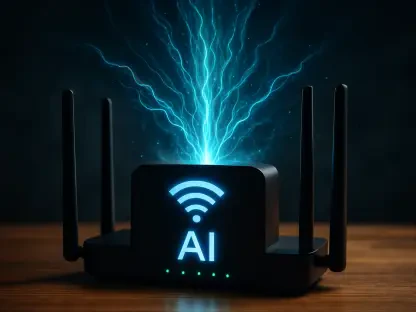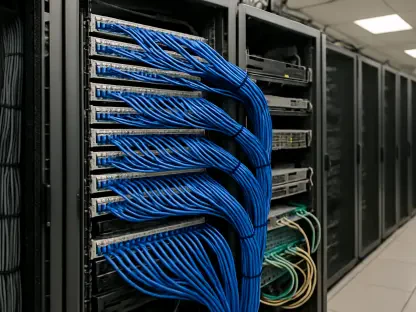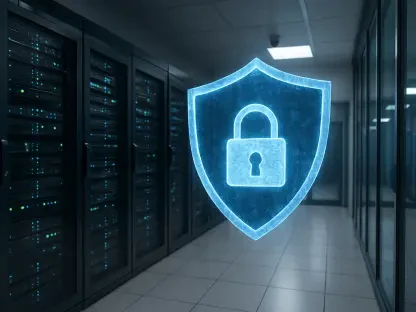As global data centers consume increasing amounts of energy due to technological advances and data processing needs, the urgency for sustainable operations has never been higher. Forecasts indicate a six-fold increase in energy usage in the UK in the next decade, underscoring the necessity for complex and sustainable storage solutions. Data center operators are actively seeking ways to reduce their environmental impact through innovative practices. These efforts are crucial not only for maintaining operational efficiency but also for addressing the broader concerns surrounding energy consumption and sustainability.
Meeting Energy Demands
Data centers require substantial and continuous power to function, leading to a growing energy footprint and higher emissions. This demand for energy is exacerbated by the rapid development of AI and massive data processing requirements. To address this, operators are adopting forward-thinking technologies that manage key operational elements effectively. One such innovation is the use of digital twins—virtual replicas of existing systems—enabling operators to detect airflow changes and adjust environmental conditions within data centers. This technology can lead to significant energy savings and operational efficiency. By simulating various operational scenarios, digital twins allow operators to optimize their setups in real time, further reducing energy consumption.
In addition to digital twins, other technologies designed to monitor and manage energy demands are being deployed. Smart energy management systems use machine learning algorithms to predict energy usage patterns and adjust consumption accordingly. These systems can anticipate high-demand periods and allocate resources more efficiently, ensuring that energy is used optimally. Such proactive approaches are essential for maintaining the delicate balance between performance and sustainability. As technology continues to evolve, the integration of advanced energy management tools will become increasingly important for the future of data center operations.
Strategic Location Choices
The geography of data centers plays a crucial role in enhancing sustainability. Industry leaders are considering the proximity of data centers to energy sources like nuclear power to reduce emissions and energy loss during transmission. Establishing data centers in colder climates is another strategy to leverage natural cooling, offering substantial sustainability and cost efficiency benefits. Building data centers strategically can result in minimized energy loss and a reduced carbon footprint, creating a positive environmental impact. Cold climates offer natural advantages that complement advanced cooling systems, contributing to greener operations.
In colder regions, data centers can take advantage of low ambient temperatures for cooling purposes. This natural method of cooling significantly reduces the reliance on energy-intensive air conditioning systems. Furthermore, locating data centers near renewable energy sources helps in utilizing cleaner power, thereby lowering overall carbon emissions. These geographical considerations are not just limited to temperature and energy sources; they also include logistical factors such as proximity to major data transmission routes and the availability of reliable infrastructure. Thoughtful site selection is therefore vital for the long-term sustainability of data centers.
Dynamic Power Management
Dynamic power management is a pivotal practice for optimizing energy consumption. By adjusting energy usage based on demand, data centers can conserve power during low-activity periods without compromising performance. Advanced systems shut down unused components and control fan speeds, minimizing waste and environmental impact. During peak times, operations can scale up to ensure reliable services while maintaining sustainability. Technologies that enable dynamic power management ensure that data centers operate efficiently regardless of demand fluctuations. This adaptive approach is beneficial not only for energy savings but also for prolonging the lifespan of the hardware.
Another aspect of dynamic power management is the use of more efficient power conversion technologies. Power supplies that can dynamically adjust their output based on load requirements can significantly reduce energy waste. Innovations like these are crucial for ensuring that data centers can meet the growing demand for data processing while minimizing their environmental footprint. Furthermore, adopting these technologies can lead to significant cost savings over time, making them an attractive option for data center operators. As energy demands continue to rise, the importance of dynamic power management will only grow.
Advanced Cooling Techniques
Innovative cooling systems are essential for reducing power consumption in data centers. Liquid cooling technologies, particularly direct liquid cooling and liquid immersion, efficiently manage heat and improve energy efficiency. Constructing centers in cooler climates further reduces the need for artificial cooling. Immersion cooling, where servers are submerged in a dielectric fluid, offers a significant advantage by lowering temperatures and enhancing energy savings. These advanced cooling techniques are instrumental in achieving sustainable operations. By keeping the hardware at optimal operating temperatures, these cooling methods also help in extending the life of the equipment.
The benefits of advanced cooling techniques go beyond energy savings. They also contribute to higher operational reliability and reduced failure rates. Liquid cooling, for instance, is more effective at removing heat than traditional air cooling, which can lead to better performance and lower maintenance costs. Implementing these systems requires an initial investment, but the long-term benefits in terms of energy efficiency and operational stability make it a worthwhile expenditure. As data centers continue to evolve, the adoption of advanced cooling solutions will be indispensable for sustainable and efficient operations.
Modular and Recyclable Solutions
Designing electronic equipment with modularity can significantly reduce electronic waste. Modular components allow for selective upgrades and enhancements, prolonging the lifespan of systems and minimizing the need for replacements. This approach maximizes resource use and fosters sustainability. Recyclable solutions also contribute to reducing environmental impact by facilitating the reuse of materials. Data center operators can incorporate modular designs to optimize equipment longevity and efficiency. By making devices easier to upgrade and repair, operators can avoid the need for frequent replacements and reduce the overall environmental footprint.
The benefits of modular and recyclable solutions extend beyond environmental considerations. They also offer significant economic advantages by reducing the costs associated with hardware replacements and enabling more efficient maintenance practices. Employees trained to handle modular systems can quickly swap out faulty or outdated components, minimizing downtime and enhancing operational efficiency. These solutions align with the broader goals of sustainability by promoting the responsible use of resources and reducing e-waste. As the industry continues to advance, the adoption of modular and recyclable solutions will play a crucial role in the sustainable management of data centers.
Integrating Heat Capture and Redistribution
Capturing excess heat produced by data centers and redistributing it to nearby facilities exemplifies the circular energy model. This practice promotes sustainability by redirecting heat, which would otherwise be wasted, to benefit local communities. Heat capture and redistribution not only enhances sustainability but also contributes to the local energy ecosystem. Data centers integrated into community energy systems exemplify innovative energy management. By efficiently reusing the heat generated, these systems can lower the overall energy requirements for heating nearby buildings, thereby reducing the carbon footprint of both the data center and the community.
Implementing heat capture and redistribution systems requires careful planning and investment, but the long-term benefits are substantial. These systems can provide a reliable source of heat for nearby facilities, reducing their dependence on traditional heating methods. This integration not only improves sustainability but also fosters stronger community relationships. Data centers become more than just isolated entities; they transform into integral components of the local energy infrastructure. As the demand for energy-efficient solutions continues to rise, the adoption of heat capture and redistribution practices will play a pivotal role in achieving sustainability goals.
Implementing Advanced Optical Technology
Optical modules are significant contributors to power consumption in data centers. Initiatives to reduce energy usage of these components include Co-Packaged Optics (CPO) and Linear Drive Pluggable Optics (LPO). These technologies optimize optical interconnect performance while lowering energy needs. Advanced optical technologies are critical in achieving energy-efficient operations. Continued research and adoption of energy-optimized optical solutions drive sustainability in data centers. By enhancing the performance of optical interconnects, these technologies also improve the overall efficiency of data transmission within the center.
The development and implementation of advanced optical technologies are not just about reducing power consumption; they also aim to enhance the overall performance and reliability of data centers. These technologies enable faster data transfer rates and lower latency, which are essential for the efficient handling of large volumes of data. As the demand for high-speed data processing continues to grow, the importance of energy-efficient optical solutions will only increase. Data center operators must stay abreast of the latest advancements in optical technology to ensure they can meet future demands while maintaining their sustainability goals.
Leading Towards Net-Zero Goals
As global data centers consume increasingly larger amounts of energy due to advancements in technology and growing data processing needs, the call for sustainable operations has become essential. Predictions show a six-fold surge in energy usage in the UK over the next decade, highlighting the urgent need for sophisticated and sustainable storage solutions. Data center operators are actively exploring methods to cut their environmental impact through innovative practices, from using renewable energy sources to implementing more efficient cooling systems. These initiatives are vital not only for maintaining operational efficiency but also for addressing the broader concerns related to energy consumption and sustainability. It is imperative for the industry to balance technological growth with environmental stewardship. As technology evolves, data centers must spearhead efforts to curb energy usage, thereby playing a significant role in the global push for sustainability. These actions are critical for long-term viability and the mitigation of climate change impacts, ensuring a healthier planet for future generations.









